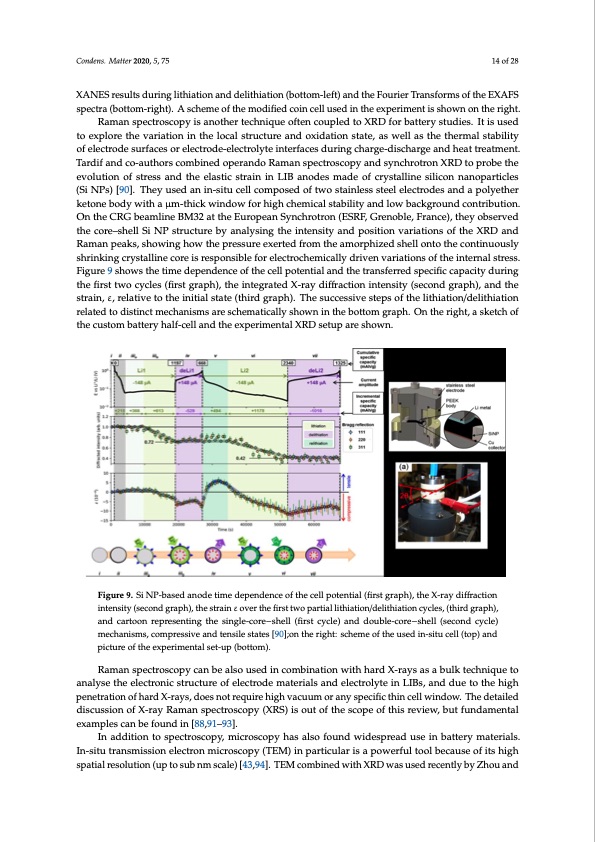
PDF Publication Title:
Text from PDF Page: 014
Condens. Matter 2020, 5, 75 14 of 28 XANES results during lithiation and delithiation (bottom-left) and the Fourier Transforms of the EXAFS spectra (bottom-right). A scheme of the modified coin cell used in the experiment is shown on the right. Raman spectroscopy is another technique often coupled to XRD for battery studies. It is used to explore the variation in the local structure and oxidation state, as well as the thermal stability of electrode surfaces or electrode-electrolyte interfaces during charge-discharge and heat treatment. Tardif and co-authors combined operando Raman spectroscopy and synchrotron XRD to probe the evolution of stress and the elastic strain in LIB anodes made of crystalline silicon nanoparticles (Si NPs) [90]. They used an in-situ cell composed of two stainless steel electrodes and a polyether ketone body with a μm-thick window for high chemical stability and low background contribution. On the CRG beamline BM32 at the European Synchrotron (ESRF, Grenoble, France), they observed the core–shell Si NP structure by analysing the intensity and position variations of the XRD and Raman peaks, showing how the pressure exerted from the amorphized shell onto the continuously shrinking crystalline core is responsible for electrochemically driven variations of the internal stress. Figure 9 shows the time dependence of the cell potential and the transferred specific capacity during the first two cycles (first graph), the integrated X-ray diffraction intensity (second graph), and the strain, ε, relative to the initial state (third graph). The successive steps of the lithiation/delithiation related to distinct mechanisms are schematically shown in the bottom graph. On the right, a sketch of Ctohnedencsu.sMtoatmterb20a2t0t,e5r,yxhalf-cellandtheexperimentalXRDsetupareshown. 15of30 FFigiguurere9.9S. iSNi NP-Pb-absaesdedanaondoedteimtime deedpepnednednecnecoefothfethcelclepllopteontteinalti(aflir(sfitrgsrtagprha)p,hth),ethXe-rXay-radyiffdriaffcrtiaocntion inintetnensistiyty((sseeccoonndgraph), the sttrraiinεεovovererthtehfierfsitrstwt towpoarptiaarltilaitlhliiatthioiant/idonel/idtheilaitthioianticoynclceys,c(ltehsi,r(dthgiradph), garanpdh)c,aartnodoncaretoporenserneptirnegsetnhtiengsinthgele-scinogrele−-schoreell−s(hfierlslt (cfiyrcsltec)yacnled) danodubdleo-ucbolree-−cosrhee−lslh(eslelc(osnedconcydcle) cymcelec)hmaneicshmasn,icsomms,pcroesmsipvresasnivdeteansdiletesntasitless[t9a0t]e;son[9t0h]e;ornigthte:rsicghhetm:secohfemtheoufsethdeinu-seitduicne-lslit(utopce)lalnd (tpoipc)tuarnedopf itchteureexpoferthime enxptaelrsimet-eunpta(lbsoett-oump )(.bottom). InInadadidtiotinontotsopsepctercotsrcoospcoyp, my,icmroicsrcospcyophyashaalsoaflosuonfdouwnidewspidreasdpruesaedinubseatitnerybamttaetreyrimalsa.tIenri-als. sIitnu-stirtaunstrmainssmioinsseiloecntreolencmtriocnromsciocproys(cToEpMy )(TinEpMar)tincuplartisicauplaorwiserafuplotowoelrbfeuclatuosoelobfeictsauhisgehosfpiatstiahligh rsepsoaltuiatliorens(oulupttionsu(ubpntmosucbalne)m[4s3c,a9l4e]).[T4E3,M94]c.oTmEbMinceodmwbiitnheXdRwDitwhaXsRuDsewdarseucesendtlyrebcyenZtlhyobuyaZnhdocuoa-nd authors to study the non-equilibrium phase transition in layer structured NMC LiNi1/3Mn1/3Co1/3O2 cathodes during cycling. The experiment was performed at the beamline X14A of the National Synchrotron Light Source (NSLS) at Brookhaven National Laboratory (BNL). A different three-phase transition behaviour was demonstrated by in-situ XRD; the 003 diffraction peak evolution of NMC electrode during the first charge is observable in Figure 10a; thanks to ex-situ scanning-TEM analysis, Raman spectroscopy can be also used in combination with hard X-rays as a bulk technique to Raman spectroscopy can be also used in combination with hard X-rays as a bulk technique to aannaalylyseseththeeeleelcetcrtornoincicstsrturcutcutruereofoeflelcetcrotrdoedemmateartiearlisalasnadnedlecltercotlryotleytieniLnIBLsI,Basn,dandudeutoethoetheighigh ppeenneetrtraatitoionnoffhardX--rrayss,,ddooeessnontorterqeuqiureirheighhigvhacvuaucumuomraonryasnpyecsipfiecctihficntcheilnlwcienlldowwin.dTohwe.dTethaeiled ddeitsaciluesdsiodniscoufsXsi-ornayoRfaXm-ranysRpaemctraonscsoppeyctr(oXsRcoSp)yis(oXuRtSo)fitsheousctoopfetohfethscisoprevoiefwt,hbisutrefvuinedwa,mbeunttal fuexnadmamplenstcaalnexbaemfpoulensdcain[b8e8f,9o1u–n9d3]i.n[88,91–93]. the authors observed the coexistence of an abnormal Li-poor region with tetrahedral Li occupationPDF Image | Synchrotron-Based X-ray Diffraction for Lithium-Ion Batteries

PDF Search Title:
Synchrotron-Based X-ray Diffraction for Lithium-Ion BatteriesOriginal File Name Searched:
condensedmatter-05-00075.pdfDIY PDF Search: Google It | Yahoo | Bing
Sulfur Deposition on Carbon Nanofibers using Supercritical CO2 Sulfur Deposition on Carbon Nanofibers using Supercritical CO2. Gamma sulfur also known as mother of pearl sulfur and nacreous sulfur... More Info
CO2 Organic Rankine Cycle Experimenter Platform The supercritical CO2 phase change system is both a heat pump and organic rankine cycle which can be used for those purposes and as a supercritical extractor for advanced subcritical and supercritical extraction technology. Uses include producing nanoparticles, precious metal CO2 extraction, lithium battery recycling, and other applications... More Info
| CONTACT TEL: 608-238-6001 Email: greg@infinityturbine.com | RSS | AMP |